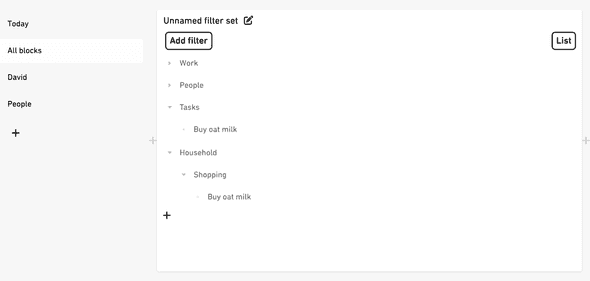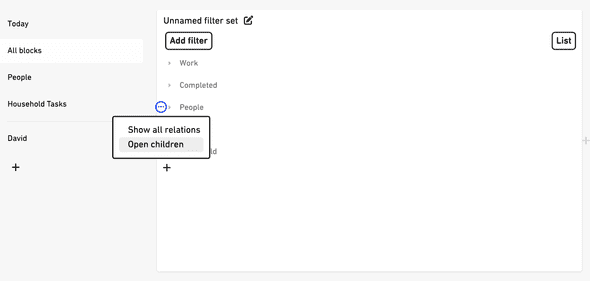List / Outline View
The list view is the default view type for all views.
It’s a filterd content view. Meaning that without any filters, you’ll get a list of all your blocks.
So filters can be used to query down to a specific subset of blocks.\
The list view is the best way to set up your own systems within Formable’s graph strucuture.
To get a better understanding of blocks and relations in Formable, you can also check out the introduction page and details dialog page.
#Indentation

The tab key can be used to create a sub list indented underneath a block.
The list view behaves differently at the root level from indented levels. At the root level you get all blocks that match the filters. Indented beneath a block, you’ll always get all its children.
The arrow next to a block can be clicked to expand or collapse its children.
#Adding blocks
To create a new block/paragraph/bullet, press the enter key.
The plus button or the ⌘ + ⏎ shortcut can be used to place an existing block into the list.
#List item popover
 Next to every block in the list is a button that opens a popover for extra actions.
Next to every block in the list is a button that opens a popover for extra actions.
It can open a new view with the children of the block, or open the details dialog.
#Keyboard actions
- ⏎
Create a new block underneath the currently selected one - ⌘ + ⏎
Search for and place an existing block underneath the currently selected one.
That action will add or remove the necessary relations to the inserted block. - ⇧ + ⏎
Line break within the block - ↹
Indent the currently selected block - ⇧ + ↹
Unindent the currently selected block - Arrow keys
Navigate the list - ⌘ + arrow up / down
Move the currently selected block - Backspace in an empty block
Delete the currently selected block - Within mention popovers, you can be navigate with the arrow keys and ⏎
- ⌘ + B
Toggle bold text - ⌘ + I
Toggle italic text
#View options
- Omit nested blocks
With this setting on, results of the filters return blocks that are children of other returned blocks will not be shown at the root level of the list.
Examples of that:- Without any filters, you’d get a long list of all blocks. Unless you’re just getting started that might be a very long list that isn’t all too helpful, because you might have hundreds or thousands of blocks.
But if most of them are children or grandchildren of other blocks you could get a useable tree of all “root-blocks”—so blocks without any parent. - Let’s say you have a list of tasks. Some tasks might be subtasks of other tasks shown, so you don’t want them at the root level. Toggle “omit nested blocks” and the ones that are nested below others will be omitted from the root list.


- Without any filters, you’d get a long list of all blocks. Unless you’re just getting started that might be a very long list that isn’t all too helpful, because you might have hundreds or thousands of blocks.
In the view switcher in the top right of the view, you can also switch to the network view.